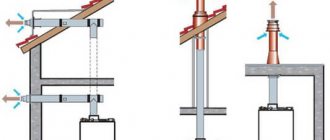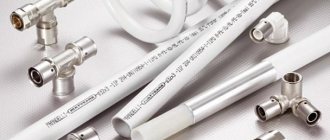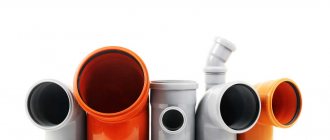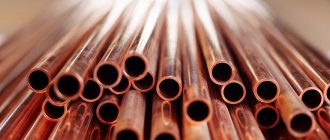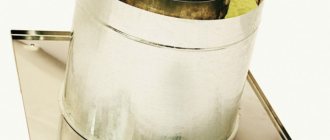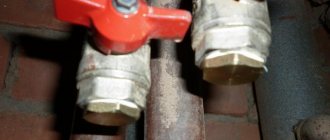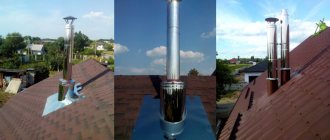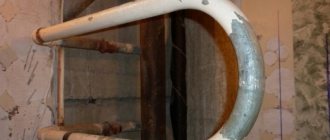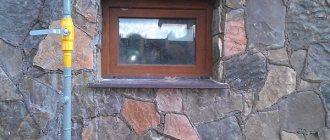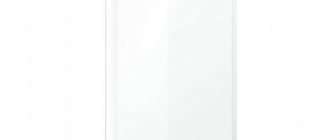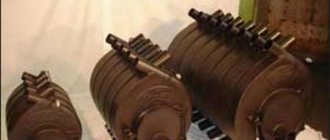Product characteristics
Corrugated stainless steel pipe has the following characteristics:
- Dimensions. Standard indicators for the internal diameter of the product are 15, 20, 25 and 32 mm. Products with larger diameters are available to order. The process of their production does not present any particular difficulties.
- Operating temperature range. The product can be used at temperatures ranging from -50...+800°C. The flexibility of the pipe, which is made of stainless steel, is maintained at -40°C. When using plastic fittings, the upper temperature of the water released through the pipes is limited to +110°C. Otherwise, the parts will melt. A short-term increase in temperature up to +150°C is allowed
- Flexibility. You can bend a water pipe in different ways, but you cannot exceed the maximum permissible bend value, equal to three times the diameter.
- Impact resistance. The pipe is resistant to high pressure and mechanical damage, so it can be used in any conditions. The product can operate at a pressure of 50 atm. The material can withstand short-term increases in the indicator up to 200 atm.
- Oxygen impermeability. This figure is close to 100%
- Roughness coefficient. The maximum value is 0.008.
- Life time. Manufacturers claim that with proper installation and use, the pipe will last at least 20 years. In our country, products began to be used no more than 10 years ago, so this statement has not been verified in practice.
Material for making corrugated pipes
Depending on the scope of use of the pipes, it is necessary to select the correct type. Corrugated pipes can be made from the following materials.
Stainless steel
A feature of such products is their long service life. When choosing, you need to consider the following advantages:
- Long service period. The product is not subject to corrosion and will last for a long period without reducing its characteristics.
- Flexibility. Allows you to easily lay pipes in the required direction.
- Reliability. Can be used not only for internal work, but also external. Has a high degree of resistance to temperature changes.
- Convenient transportation.
The material is rarely damaged by pests and has an attractive appearance; such criteria allow the use of pipes without harm to the interior of the room. They can be made from light and heavy alloy. Heavy metal products are used for underground work. May become corroded with prolonged use.
Aluminum products
This type allows the use of pipes in various fields. Suitable for industrial and domestic work. Advantages of building materials:
- flexibility, the material can bend in the desired direction without causing fractures;
- corrosion and mold do not appear;
- easy to install;
- light weight; no need to install additional supports.
However, it should be noted that the product is easily deformed under mechanical stress. Most often used for ventilation systems and air ducts.
PVC pipes
The product is used for various communications and has the following advantages:
- resistance to high temperatures;
- do not emit harmful components, therefore they can be used for interior decoration;
- long service life without mold and corrosion.
Among the large list of positive qualities, it is necessary to note such a disadvantage as intolerance to low temperatures.
Polyethylene pipes
This type of material is gaining great popularity among construction companies. The advantage of pipes is as follows:
- corrosion does not occur, which is why such products are often used for sewage;
- low cost;
- withstands large mechanical loads;
- The product is compact and can be transported over long distances.
However, when choosing this type, you need to know that there is no resistance to UV rays.
Recommendations for choosing a hygrometer
Modern hygrometers differ not only in functionality, but also in size, price and measurement accuracy.
Standard humidity is considered to be between 40 and 60%. Humidifiers or dehumidifiers can be used to create optimal indoor conditions.
The most optimal type of devices are considered to be digital devices, for the use of which you do not need to make any calculations or have any professional skills.
Such a hygrometer should be selected based on the following criteria:
- manufacturer's permissible measurement error;
- width of the range of operating values;
- heating threshold if the device is planned to be used in saunas or baths;
- speed of calculation of results;
- compactness and mobility;
- the presence of additional options - clock, calendar, alarm clock, barometer, built-in Wi-fi module and others;
- price category and manufacturer.
Before purchasing a hygrometer, you should carefully study not only the characteristics of devices offered on the market, but also reviews from customers who have already tested the device in action.
By purchasing a high-quality hygrometer, you can be confident in the accuracy of relative humidity measurements. However, a number of related questions arise about how to normalize the microclimate and what methods and devices to use to normalize indicators.
Corrugated chimney pipes: overview of various materials, their advantages and disadvantages
Combustion products from the operation of gas appliances are invisible, but this does not mean at all that there is no accumulation of carbon monoxide, which is dangerous to humans.
Therefore, absolutely any equipment that runs on gas, be it a gas water heater or heating boilers, must be provided with a chimney. A typical material for making hoods is heat-resistant brick. Gradually, brick chimneys began to lose their position with the advent of corrugated metal pipes on the building materials market, which are currently used for installing exhaust systems.
Types of pipelines
Modern retail chains offer consumers a wide range of plastic corrugated pipes.
They can be used both for the installation of the entire ventilation system, and for inserting or repairing small fragments of the chimney.
The most popular pipes are corrugated products made of stainless steel and aluminum.
Aluminum
Corrugated aluminum alloy pipe is used to remove combustion products from gas devices, both in the private sector and at industrial facilities.
The material for the manufacture of such a multilayer product is aluminum foil with a width of 5.0 cm and a thickness of only 0.1 mm. The corrugation is reinforced with a steel spiral to provide the necessary rigidity and allows you to easily change the direction of the chimney pipe. The inner surface of aluminum corrugated pipes can be ribbed or smooth.
Manufacturers produce aluminum chimneys with a wide range of pipe diameters (from 80 to 300 mm), which is sufficient for the installation of manufactured ventilation system equipment.
The popularity of using aluminum corrugated pipes is little subject to change and is based on undeniable advantages, namely:
- low specific gravity does not require the use of special mechanisms during assembly;
- low cost of products compared to analogues made of galvanized iron;
- high elasticity facilitates the removal of exhaust systems in any required direction;
- the ability to shrink and stretch at certain intervals, allowing you to avoid unexpected difficulties during construction work;
- significant resistance of the material to external aggressive environments;
- Elementary installation does not require special knowledge and experience.
It should be noted that along with the positive properties, there are still disadvantages to aluminum corrugations:
- low resistance to mechanical stress and damage;
- high thermal conductivity, to reduce which an external coating of insulating material is installed.
Stainless steel
Structurally, corrugated stainless steel metal pipes are similar to aluminum pipes, but have some distinctive properties.
For example, they can be used at fairly high temperatures (about 900 degrees) without significant damage to the building structure and material. And they can effectively remove combustion products from fireplaces, boilers, stoves operating on different types of fuel - gaseous, solid and liquid.
The positive characteristics of stainless steel corrugated pipes are:
- uncomplicated joining of elements - individual pipe elements are connected using clamps and adapters;
- maintainability;
- minimal need for components.
Accordion pipes made of stainless steel, along with undeniable advantages, are still endowed with negative properties:
- the need to insulate chimneys with thin walls to prevent condensation on the internal surfaces;
- fragility of metal exhaust systems compared to rigid ventilation systems.
Features of chimneys made of corrugated pipes
Application area
Repair of curved brick chimneys
Corrugated steel chimneys are designed to complete heating equipment operating on liquid, gaseous and solid fuels, and can be used with almost any type of boilers, boilers, water heaters and fireplaces, as they have good tightness and heat resistance.
The installation of such a chimney has a positive effect on the operation of heating boilers.
Corrugated stainless steel pipes can be used for the device:
- internal chimneys;
- external chimneys;
- adapters connecting the outlet pipe of the heating device to the main chimney;
- as well as for lining (repairing) brick chimneys with bends.
Clamp for attaching the corrugation to the outlet pipe
Chimney design
Steel corrugated chimneys are made in the form of cylindrical pipes made of individual corrugated strips twisted in a spiral with a thickness of 0.12 mm to 1 mm .
The strips are connected around the circumference with a continuous interlocking seam, which ensures tightness, flexibility of the chimney and its ability to compress and stretch to a certain length. This may be necessary during installation, for example, to attach a pipe to the boiler outlet.
Such pipes have different cross-sectional sizes, so they are easy to match to any outlet pipe.
No welding is required to connect corrugated steel pipes; they are fastened together with clamps while simultaneously attaching thermal insulation. This installation method is very convenient, since if necessary, the corrugated chimney will be easy to disassemble to clean it of soot, and then reinstall it in place.
No. 2. Chimney made of steel pipe
For gas and solid fuel boilers, steel pipes are best suited, but at the same time it must be stainless, heat-resistant and acid-resistant, since sulfur particles, which are found in almost every type of fuel in varying quantities, when combined with moisture and coal particles form aggressive environment. Stainless steel can withstand temperatures up to 500C; pipes with a wall thickness of 0.6 mm are used for chimneys, but for solid fuel boilers it is better to use steel with a thickness of 1 mm. Steel pipes are a whole system of straight sections and various shaped elements, incl. adapters, bends, tees, etc. Such a system can be installed independently or built into an existing brick channel.
The main advantages of steel pipes:
- simplicity and high speed of installation, because the weight of the structure is small, there is no need for a foundation, and even not the greatest professional can assemble the entire system from ready-made elements without any problems;
- repair work is easy to carry out;
- soot particles do not accumulate on smooth walls, their surface is easy to clean, so we can talk about consistently high aerodynamic characteristics for the passage of exhaust gases;
- high corrosion resistance;
- the ability to create complex structures;
- high tightness, due to which you can create forced exhaust.
Among the disadvantages is the high cost, especially when compared with a brick or ceramic analogue, but if simplicity and speed of installation, light weight and resistance to aggressive environments are important, then it is better to choose a steel chimney. Disadvantages sometimes include low heat resistance, but for modern boilers with a slow combustion system, greater heat resistance is unnecessary.
Depending on the characteristics of the room, boiler and climate, one of the following types of steel chimneys is used:
- single wall steel pipe consisting of one layer of stainless steel. This is the simplest and cheapest option; such a chimney is laid in a specially laid vertical channel. Often such chimneys are installed in a bathhouse, and the heat released from the steel pipe is used to heat water;
- Single-wall steel pipes for reconstruction of a brick chimney can be oval in shape. Such a restoration process and adaptation of an existing chimney to work with a gas boiler is called “linering”;
- double-walled sandwich panels consisting of two steel pipes, in the space between which a layer of insulation (basalt wool) is placed. Using the latter allows you to prevent the formation of condensation inside the pipe, while its outer surface hardly heats up. Ease of assembly and excellent performance allow such systems to be used both indoors and outdoors on the wall;
- coaxial chimneys made of steel also consist of two pipes placed one inside the other, only there is no insulation between them, and the resulting space is intended to supply air to the boiler to support combustion. Combustion products are discharged through the inner pipe. Such chimneys do not behave very well in harsh domestic winters. Cold outside air passing through the outer pipe can sometimes greatly cool the inner pipe and the gases flowing through it. This leads to a sudden drop of condensate and its freezing on the surface of the pipe. The chimney gradually becomes clogged, and the automation, reacting to this, turns off the boiler, so in this case it is better to equip chimneys with two separate pipes.
It is worth noting that sometimes thick pipes made of low-alloy steel are used to construct a chimney - this option is usually found in sauna stoves. Also, craftsmen sometimes use cast iron sewer pipes for the same purposes.
Requirements and structure of a corrugated chimney
Before you buy a flexible chimney, you need to know exactly what characteristics and features it has:
- High throughput, with low aerodynamic drag;
- The walls must be smooth, and the cross-section must be selected appropriately. Which, in turn, makes the traction work optimal and allows all combustion and fuel decay products to be removed through the pipe in a timely manner;
- The ideal pipe is one that will be fixed and connected to the heating equipment and, in a strictly vertical position, exit through the ceiling to the roof.
However, such flexible corrugated pipes have their own characteristics, which makes it possible to construct the most complex systems from them, which will contain all kinds of tees, adapters, adapters and other accessories.
The price of a flexible chimney may vary, and if a standard system with several straight sections is relatively inexpensive, then quite complex variations, with many transitions, rotating elements and brackets, will cost 2-5 times more than the standard.
Also, when constructing such a chimney, it is important to remember that such a hood must be of sufficient quality and safe. That is, each of its joints and seams will be sealed, the inner surface will be perfectly smooth, and no condensation will form on it. And the most important thing is that the chimney should withstand high temperatures and their sudden changes, be easy to clean and, if necessary, any section of it can be removed, replaced or repair work carried out on it.
Corrugated or flexible pipes have the following distinctive characteristics:
- They have a round cross-section, the size of which is selected and determined strictly individually;
- It is based on non-toxic and infusible materials, which can be aluminum or steel, the thickness of which does not exceed 1 millimeter;
- The steel strips are rolled up and connected to each other, forming a spiral-shaped pattern;
- Rigidity and flexibility are achieved due to the presence of wire between the steel strips;
- Due to their unsurpassed flexibility, the pipes are able to bend at an angle of up to 90 degrees, while the internal cross-section retains the optimal size so that all gases and waste products can fully pass;
- Also, the undoubted differences and advantages of such flexible pipes include the fact that they can be stretched to incredible sizes, while the quality of the seams and metal does not deteriorate. For example, a section 60-70 centimeters long can be stretched to 300-350 centimeters;
- The base is most often stainless steel or aluminum alloy. More specifically, for such structures a material is used that contains a small percentage of carbon; this coating can last about 10-20 years, while no rust or corrosion will form on its surface;
- The best grade of steel is considered 08x18H10.
Also, the undoubted advantages of such systems include:
- Flexible stainless chimneys can be installed in the most inaccessible places, in those areas that are very difficult to approach and are capable of bending at a certain angle;
- Even an inexperienced person can install and assemble such a system with his own hands;
- The pipes stretch and bend perfectly, so with their help you can implement even the most complex and at first glance impossible project;
- In most cases, joints in such systems are completely absent, which makes such systems very safe and completely sealed;
- This hood can be used in any conditions, it performs well even in severe frost, condensation does not form on the inner surface, and the pipes do not freeze;
- They are characterized by durability, resistance to corrosion and rust;
- The cost of such pipes is an order of magnitude lower than similar sandwich systems and other variations.
A flexible steel chimney can represent either the entire system or complement certain areas of it. For example, you can add such a flexible element to a brick or sandwich chimney. Flexible pipes are often used in connection areas with boilers, furnaces, water heaters and fireplaces.
If you want to save your money profitably, we recommend choosing pipes based on such a relatively inexpensive material as aluminum. The advantages of the coating include durability, good shock and mechanical resistance, and low weight. This variety also has its drawbacks, which include the fact that such a hood can withstand heating up to no more than 500 degrees Celsius; if the temperature rises, the material will begin to lose its tightness and will gradually collapse.
Therefore, we recommend that you do not save money and give preference to flexible pipes that are more durable and better in their characteristics and qualities, which are based on steel. This material stretches very well, and unlike aluminum it weighs a little more. This option is capable of operating at temperatures up to 900 degrees Celsius, which allows them to be used in the most difficult cases, even in conjunction with a boiler or solid fuel stove.
Depending on the need, such corrugated chimneys can be placed and mounted both inside and outside the house, left in their original state or decorated and enclosed in a special box made of brick and other non-combustible materials.
Sections of such pipes must be connected and joined together only by condensate; the upper section must be inserted into the socket of the lower one. For fixation, steel clamps and aluminum tape are used; it is also necessary to trim the edges to achieve complete tightness and reliability of this design.
If you are going to install such a chimney, it is important to remember that the first section that will go from the boiler must be exclusively vertical and have a length of at least 500-600 millimeters. It is important to install a gate valve at the very beginning of the system, take care of the presence of a condensate collector, which ideally should be supplemented with a special tap. If the height of the ceiling in the room is less than 2.7 meters, then the first section can have a vertical length of 250-300 millimeters.
If the chimney will have horizontal sections, it is necessary that their length does not exceed 3 and 6 meters, depending on the height of the ceilings in the room. The pipe can have about 3 turns, but make sure that the radius is not less than the cross-section of the pipe. A distance of 5 centimeters must be maintained between the pipe and flammable coatings of walls and ceilings; for fire-resistant coatings, this figure is reduced to 2.5 centimeters.
Advantages of using flexible corrugated pipes in heating systems:
1. Resistance to corrosion and siltation:
The material from which the pipes are made (SUS304 stainless steel) and the nature of its processing (polished steel strip) allow the use of flexible corrugated pipes in heating systems where both process water and other combined coolants are used as a coolant.
2. High temperature resistance:
The operating temperature of pipelines made of flexible corrugated stainless steel pipes (with connecting elements - fittings for corrugated stainless steel pipes) is up to + 150 ° C, which allows not only their use as the main pipelines of the heating system, but also in places of connection to main sources or distribution access points to coolant with elevated temperature conditions.
3. Resistance to defrosting:
Perhaps the most important advantage of flexible corrugated stainless steel pipes, which are used as pipelines for heating systems, is their unique resistance to “defrosting” of the heating system.
Unlike all other types of pipes used in the installation of heating systems (copper, steel, metal-plastic, polypropylene), flexible corrugated stainless pipes when “defrosting” (freezing of the coolant in the heating system) do not collapse or fail, but completely retain their operational properties. quality, and after heating or replacing the coolant in the system, they are ready for further full use.
This phenomenal quality is achieved due to the corrugated structure of the pipe. When freezing and as a result of expansion of the coolant, the pipe immediately compensates for the linear expansion of the pipeline, preventing the occurrence of excess pressure on the walls of the pipe and at the pipe-fitting-heater joints, thereby maintaining the integrity and functionality of the entire defrosted pipeline system.
4. Resistance to water hammer:
The same corrugated structure of Lavita heating pipes guarantees the integrity of pipelines in the heating systems of residential apartments, administrative, commercial and technical premises during periods of routine work on pre-season preparation for pressure testing of heating systems or in moments of destructive water hammer.
Pipelines made of corrugated stainless steel pipes and brass fittings can withstand excess pressure in the system up to 60 atm.
5. Does not require subsequent preventive maintenance:
Pipelines for heating systems made using corrugated stainless steel pipes do not require any pre-season or off-season preventive maintenance in the form of tightening union nuts of fittings or flushing the pipeline system.
The service life of a stainless steel pipeline is not limited.
The service life of silicone gaskets in fittings is up to 30 years.
6.Easy to install:
To carry out all types of work on the installation of pipelines of heating systems and connecting heating devices, no special skills or the use of expensive installation methods (welding, use of hydraulic or electrical tools) are required. All work is performed only with the use of two open-end wrenches or adjustable wrenches. The lightness of the material and convenient packaging make it possible to manufacture individual sections of the pipeline directly at the installation site, while ensuring 100% accuracy of the required dimensions and, accordingly, 100% savings in material.
7. Cost savings:
The unique properties of corrugated pipes: flexibility, low weight, convenient packaging, and ease of installation together allow for comprehensive savings of up to 30% in logistics and labor costs for organizing pipelines for heating systems compared to organizing such pipelines from other types of pipes (polypropylene, metal-plastic, copper, etc. ).
However, the main savings when using corrugated stainless steel pipes in heating systems is the most favorable price compared to analogues offered by the Lavita company.
Types of corrugation
The modern market is rich in various types of such pipes, but it is worth remembering that not all of them can be used, as they may not meet some requirements. Let's look at the main types of pipes and their classification.
1. Aluminum corrugated pipes are made of multi-layer laminated foil, and their diameter is up to 150mm. If we talk about price, then this pipe will not cost much, but it is very durable. There is a steel wire inside it, which serves to give the pipe the required shape.
2. If we talk about another option, then a corrugated stainless steel pipe will not differ much from aluminum, but such pipes are much better. They can be used at high temperatures, for example, the temperature in the boiler can reach 900 degrees. But the advantages do not end there, since a corrugated stainless steel pipe for a chimney can effectively cope with combustion products.
This material also has other advantages. The main one is that, in fact, the pipe is corrugated - annealed stainless steel, which can withstand high temperatures and can be used anywhere: not only on gas boilers, but also in fireplaces and stoves using solid fuel.
• ease of installation due to flexibility and elasticity;
• it can be used at any angle, this is especially important for heating, since it is in such cases that the most difficult to reach places are observed;
• ease of installation, since the use of additional building materials, for example, corners and all kinds of adapters is not required;
• corrugated stainless steel pipe is suitable for installation indoors and outdoors;
As has already become clear, such a pipe is an excellent option for solving many problems. It is worth noting that the chimney is attached to the house structures using special brackets; most often they come complete with the pipe.
Sometimes it is necessary to reproduce the connection between two pipes, then it would be more correct to use metal tape. It is very tight and does not allow combustion products to pass through at all. The product does not weigh too much, so it can be installed on any structure. The load will be minimal, and you will not have to forcefully fix it.
Depending on the material from which the flexible chimney is made, there are two types of corrugations:
- aluminum;
- made of stainless steel.
Corrugated stainless steel chimney
Aluminum corrugation
Relatively recently, corrugated multilayer aluminum pipes were used for the manufacture of flexible chimneys. However, for heating boilers operating on solid fuel, aluminum chimney corrugation is not suitable because it cannot withstand high temperatures.
In some regions, the use of such pipes is strictly prohibited. As the temperature increases, aluminum undergoes deformation, which can result in the walls of the chimney system burning out, resulting in consumers suffocating from gas leaks.
Steel corrugation
The design of stainless steel chimneys is similar to aluminum ones, but steel pipes have improved technical characteristics. They are used in systems with heating boilers powered by liquid and solid fuels. They function effectively at temperatures up to 900°C without undergoing deformation.
Corrugated stainless steel chimney is used in devices with high operating temperatures. They can be installed in private homes to remove combustion products from kitchen gas water heaters. In them, the outlet gases are heated to 300°C. Steel pipes are used for chimneys of heating units, in which temperatures up to 900°C are reached.
This material can be used for repairing old chimneys, as well as as adapters when installing smooth steel pipes. Stainless steel corrugation is also used as a connection for household appliances in the house. In this case, it is necessary to install fittings made of brass and stainless steel with linings of dielectric material to avoid sparks.
Advantages of flexible chimneys made of stainless steel and aluminum:
- used for heating systems and removal of waste combustion products of various levels of complexity;
- increased strength of the entire structure;
- easy installation;
- resistance to sudden temperature changes;
- the material used is not subject to destruction due to corrosion;
- the round shape of the pipe section does not allow combustion products to accumulate on the inner surface of the chimney, which simplifies maintenance;
- atmospheric phenomena and aggressive environments do not destroy the material;
- tightness of connections and transitions.
The disadvantage of corrugated chimneys is the use of insulation. At low temperatures, moisture forms on the inner surface. Insulation is carried out when installing the chimney along the wall and partially on the street, as well as when using thin single-layer modules.
When installing corrugated stainless steel pipes for chimneys, safety requirements must be observed. Manufacturers recommend following the following rules when installing:
- Installation of corrugated pipes begins with the selection of the internal diameter of the product; it must correspond to the size of the outlet hose from the heating boiler.
- The structural size of the chimney itself is calculated based on the rated power of the heating unit. The average value is considered to be 19 kW; a corrugation with a diameter of up to 110 mm is installed for it; with increasing power, the size reaches values of up to 130 mm.
- To ensure high efficiency of the system, when exiting the boiler, the vertical pipe should not be less than 1 m long. To achieve tightness, the upper part of the chimney is inserted into the lower part and secured with clamps. Sometimes metal tape is used for sealing.
- In new houses, for the sustainable removal of waste combustion products, a chimney should be installed on a horizontal section no more than 3 m long, and in old premises no more than 6 m long.
- In places where the corrugated pipe system passes through walls and ceilings, special adapters and materials that are not subject to ignition at high temperatures are made. The pipes are wrapped with mineral wool.
- It is prohibited to lay a corrugated chimney in residential premises, entrances, loggias and balconies. It is also not recommended to install pipes through walls with access to the street.
- When installing a flexible chimney from geysers, manufacturers advise installing the outlet with a right angle bend. Some designs use a condensate collection device.
Sometimes corrugation is used to modernize an old brick chimney that has failed over time. Also, when the axis of the riser of the exhaust gas removal system is displaced, steel pipes are installed.
Today you can find different types of metal corrugated pipes on sale, but according to modern requirements, not all of them can be used for installing chimneys.
Aluminum
Previously, aluminum chimney corrugation was used everywhere to remove combustion products from gas heating appliances and water heaters. This is a flexible pipe made of laminated multilayer aluminum foil with a diameter of 100–150 mm, quite durable and inexpensive. A steel wire is inserted inside the pipe to give it shape and direction.
Having an initial length in a compressed state of 65 cm, the aluminum corrugation stretches up to three meters, which allows you to vary the length of the chimney or air duct within these limits. And if extensions are necessary, the pipes are fastened together with metal tape.
Aluminum corrugation
An aluminum corrugated chimney pipe is not installed on stoves, fireplaces and boilers that burn solid fuel, as it cannot withstand high temperatures. And now gas service specialists strongly do not recommend using them for gas water heaters and boilers.
We suggest you familiarize yourself with what threads are needed for crocheting rugs
The design of corrugated stainless steel chimneys is similar to aluminum ones, but their characteristics are much superior to them.
Chimneys, for the assembly of which a corrugated stainless steel pipe was used, can operate at very high temperatures (up to 900 degrees) without serious damage to the material and structure, effectively removing combustion products not only from gas appliances, but also from boilers, stoves and fireplaces. liquid and solid fuel.
Properties of a corrugated stainless steel pipe used for installation of chimneys:
- Flexibility;
- High tensile and compressible properties.
Various materials are used for the production of corrugated pipes, but not all of them are suitable for chimneys. Their main types:
- aluminum;
- steel (stainless steel).
The aluminum corrugation is made of laminated foil having several layers. A pipe made from this material has a diameter of 100 to 150 mm.
It is reinforced from the inside with steel wire to give the required configuration. Its compressed length is 65-70 cm.
When stretched, the length reaches three meters. This quality allows you to change the length of the entire chimney. If the pipe needs to be extended, two or more parts are fastened together with metal tape.
Its design is quite simple. But due to the fact that this material does not withstand too high temperatures, it cannot be used for systems that provide solid fuel for heating.
Corrugated stainless steel pipes are a similar design. But their quality characteristics are much higher. They are able to withstand temperatures up to 900 degrees, which allows the use of almost any fuel for heating. In this case, combustion products are removed quite efficiently.
Advantages and disadvantages of corrugations for smoke removal
The main difference from straight pipes is elasticity and flexibility, due to which corrugated pipes can easily be rotated to the desired angle. At the same time, bends or swivel elbows are avoided, which has a positive effect on the final cost of the product.
A corrugated pipe is a hermetically sealed connection; when installing joints, welding of joints and the use of sealants are not required, due to the ability of the corrugated pipe to stretch in length and change the angle of inclination. This property of the pipe significantly reduces the risk of depressurization of seams and, as a result, gas poisoning.
Flexible chimneys are easy to use: they heat up quickly and less condensation forms on their walls. High, low temperature and humidity do not affect the technical characteristics of the pipe.
Corrugated chimneys are easy to install. A flexible chimney can be used for installation of both internal and external structures. The connection of individual parts of the corrugation is carried out using metal tape and steel clamps.
There are few disadvantages to a corrugated chimney:
- firstly, it has a short service life, since the steel pipe has fairly thin walls and quickly burns out, especially when operating under significant temperature loads;
- secondly, the pipe requires additional insulation to reduce the process of condensation formation.
The draft in a corrugated pipe is significantly lower than in a smooth pipe. Therefore, vertical installation of corrugation along the entire length of the chimney is impractical.
Installation of corrugated pipes
Such a device has a lot of advantages - for example, if necessary, the finished pipe can be bent at an angle of up to 180 degrees or stretched, increasing the length by more than three times relative to the original value. In this case, a very important factor is that such manipulations with the pipe do not affect its integrity at all (if you do not bend it too many times, of course).
The only thing that needs to be done separately is to install the insulation of the corrugated pipe, which is necessary to prevent heating of the outer part of the chimney. Most often, rolled basalt wool is used for these purposes.
Installation of corrugations for a chimney
The assembly of this simple structure must be done in the following order:
- Choose a location for the heating unit so that the chimney is straight and vertical. This means that along its path the chimney should not encounter any obstacles that must be bypassed. This mainly concerns transfers on the interfloor ceiling and rafter system.
- Install the elbow at the outlet of the boiler or gas water heater. Instead, flexible corrugation made of aluminum or stainless steel can be used. It should be noted that this area is almost never insulated from the outside, since the temperature of the furnace gases in this place is high and condensation does not form.
- Next, the straight section is installed with the installation of clamps and fastening to brackets (for a wall-mounted chimney).
- It is advisable to make the outer part, rising above the roof, from an insulated sandwich pipe; if necessary, install guy wires made of stainless or galvanized wire.
- Install a safety device in the form of a cap on the pipe.
- Install a condensate trap.
Tips for choosing corrugated pipe
In order to avoid possible mistakes when choosing a corrugated pipeline, the following recommendations must be followed:
Determine scope of use
It is important to choose the right product, depending on the purpose. Corrugated pipe for electrical wires cannot be used for gas and water supply. Number of layers
For water supply and gas supply, it is recommended to use two-layer products. Weight. Heavy metal pipes are used to pour into concrete. Lightweight materials can be used for exterior decoration; Choose the correct diameter. Before purchasing, you must carefully calculate the required diameter of the corrugated pipe.
When purchasing, you should first consult with a specialist who will help you choose the required type and size.
Advantages and disadvantages of corrugated chimney pipes
The positive aspects of using corrugation for such purposes include the following points:
- The chimney cross-section in the form of a circle is the most favorable for the passage of gases. The flow rises along it in a spiral, due to which stagnant zones are created in the corners of the square or rectangular channel, in which the moisture present in the smoke actively condenses. It becomes a “trap” for unburned fine particles of fuel. This mixture becomes soot, which can completely block the smoke channel, making further operation of the heating unit in the house impossible.
- Simple joining of individual elements of the chimney pipe. All you need is a simple adapter and a couple of clamps.
- Simple and affordable repairs involving simple dismantling and easy assembly of a new smoke duct.
- The need for various components is minimal, since corners, turns and other similar elements are not used.
- Convenience of laying a chimney with changes in direction if you need to bypass obstacles in the form of rafters and other structural elements.
However, there are several negative aspects of their use:
- Small wall thickness (0.1 mm), which leads to active cooling of the chimney and is accompanied by the formation of a large amount of condensate, and therefore soot. A smoke duct made of heat-resistant corrugation requires careful and high-quality insulation.
- The unevenness of the inner surface of the corrugation walls, which contributes to increased formation of condensation and soot.
Most often, corrugated pipes are used to install liners in brick or other channels in the shape of a rectangle,
as well as in the places where the boiler is connected to the smoke exhaust duct.
Corrugated stainless pipe: history of invention
An invention such as a corrugated stainless steel pipe appeared at the end of the twentieth century. Its authors are Japanese scientists who were looking for the best option for laying communications in conditions of increased seismic activity on the islands. This is how a universal product appeared, combining the flexible qualities of rubber and the strength of steel. It took world experts very little time to come to the general conclusion that flexible metal pipes have a number of advantages over their analogues made of cold-rolled sheet steel, as well as over polypropylene and metal-plastic pipes.
Flexible stainless pipes gradually replaced steel and polypropylene structures
In this regard, almost immediately after the invention of corrugated pipes, their mass production began in Germany, and then in South Korea, which is currently the leader in the production of flexible stainless steel pipes. Well-known companies involved in their production include Korean. Due to the popularity of the brand, the metal corrugation is also called a cofulso pipe. Gradually, enterprises in different countries began to specialize in the production of corrugated products, and their use became widespread in the installation of utility networks and other communications.
Characteristics of Corrugated Stainless Steel Pipe
Thus, flexible stainless pipes gradually replaced steel and polypropylene structures, as well as metal-plastic communications used in the creation of plumbing, heating, ventilation and even gas systems. The strength of the material is ensured by the fact that only high quality stainless steel with admixtures of nickel, chromium and carbon is used in the production process.
Interesting to know. The degree of concentration of additional elements such as nickel, chromium and carbon in the alloy is calculated with extreme accuracy. This guarantees the strength, durability of the corrugated pipe and its resistance to corrosion.
The manufactured material must comply with a certain list of characteristics that guarantee certain product quality standards, in particular:
The strength of the material is ensured by the fact that only high quality stainless steel is used in the production process
- Normal operating pressure is 10 atmospheres with a permissible maximum load of 60 atmospheres.
- During operation, a corrugated stainless steel pipe can withstand the temperature of the passing substance from 0 °C to 100 °C. In this case, the maximum limit can reach 150 °C and above.
- Pipelines for organizing construction work and individual repairs, depending on the scope of application, are produced with a diameter of 15, 20, 25, and 32 mm.
Stages of production of corrugated stainless steel pipes
The special corrugated design provides this type of pipe with a high degree of flexibility.
The versatility and high quality performance of stainless steel corrugations are due to strict adherence to its manufacturing technology, which, surprisingly, is quite simple. The production process itself includes the following stages:
- A pipe is formed using a special steel tape.
- Workpieces are cooked using tungsten electrodes. At this stage of production, special automatic TIG equipment is used. The process occurs at high temperatures, which can reach 1150 °C.
- The reliability of the seams is checked using a special laser installation.
- The corrugation is formed using special shafts of various diameters.
- Perform heat treatment of parts. Different types of pipes are susceptible to a certain degree of temperature exposure, since annealed pipe has a higher degree of flexibility.
- Products are packaged. Pipes are divided into sections of a certain length. Products with a small diameter are rolled into coils, and thick parts are packaged in groups.
- They check the quality and filter out defects in the form of products with microcracks. For this purpose, a metal corrugated pipe is placed in a liquid under high pressure. In this case, a special device is attached to each bay and the pressure is gradually increased to 10 atmospheres, then it is gradually reduced.
Pros and cons of flexible chimney pipes
A flexible chimney is valued for its huge list of positive aspects:
- Long service life. With proper care, corrugation is ready to last more than 10 years.
- High resistance to thermal influences. Chimney pipes are distinguished by greater heat resistance.
- They are not afraid of atmospheric influences, precipitation, rain, snow, fog. Besides, I don’t care about frost and temperature.
- The device does not attract birds and other living creatures.
- Resistantly withstands the effects of chemicals and other aggressive agents.
- High resistance to mechanical stress.
- High permeability of exhaust gases due to smooth walls.
- System versatility, great for any heat source.
- Easy to install.
- Profitable price.
- Maintainability.
- There is no need to build an additional foundation for the chimney.
- Safety. The high tightness of the corrugation prevents gases from entering the room.
A safe chimney for a stove can be made from stainless pipes and components
In addition to the positive aspects, a corrugated stainless steel or aluminum pipe for a chimney also has a number of disadvantages:
- The need to insulate the entire system.
- Frequent inconsistency with the architectural style of the building itself.
- A strong structure is required for the construction of tall corrugated chimneys.
In principle, some disadvantages can be solved quite simply; you can purchase corrugated sandwich panels.
Types of flexible chimneys
The flexible corrugated chimney is divided into two types depending on the material from which it is made: aluminum or steel.
Aluminum corrugated chimney
Previously, pipes made of aluminum multilayer corrugation with a diameter of 10 to 15 centimeters, made of laminated foil, were used everywhere for chimneys. This is a durable and inexpensive material.
But for fireplaces and boilers operating on solid fuel, such a pipe is not suitable, since it cannot withstand high temperatures. Moreover, at present, even gas workers do not recommend using it for the corresponding boilers and water heaters. The reason lies in the fact that when heated, the walls are deformed and there is a risk of fire.
Stainless steel chimney
The design of chimneys made of stainless steel is the same as that of aluminum pipes. However, the technical characteristics of stainless steel differ significantly. Stainless steel chimneys are capable of functioning in systems operating on liquid and solid fuels at temperatures reaching 900 degrees, and effectively cope with the removal of combustion products.
Flexible steel chimneys are used for various types of heaters, boilers, boilers and fireplaces due to their excellent tightness and heat resistance.
But high security also comes with a high price. It is approximately three times higher than the cost of aluminum chimneys. When choosing steel corrugation for arranging a chimney, you need to choose only certified products. Service life is also important. For example, Lex Flex brand corrugations last at least 40 years.
Types of flexible pipes for smoke exhaust ducts
The modern market for corrugated pipes offers various types of these products. But not all of them meet safety requirements and can be used for a chimney. There are designs made of aluminum and stainless steel.
A safe chimney for a fireplace or stove can only be built from stainless pipes and components
Some time ago, aluminum pipes were used for the chimneys of water heaters and gas heating appliances. This multilayer corrugation is a pipe made of laminated foil with a diameter of 10-15 cm. It is durable and inexpensive. In order to give the required shape, a steel wire is inserted inside.
When compressed, the aluminum pipe has a length of 650 mm, and when stretched, it is up to 3 meters. You can use metal tape to extend the air duct.
Note! Boilers and fireplaces that burn solid fuel do not have an aluminum pipe installed, since it is not able to withstand high temperatures.
Currently, such corrugation is not recommended at all.
Stainless steel corrugated pipes are structurally similar to aluminum ones, but their characteristics are much better. The material can withstand temperatures up to 900 °C without damaging the duct structure and at the same time effectively remove combustion products from devices using liquid, solid and other types of fuel (boilers, fireplaces, stoves).
